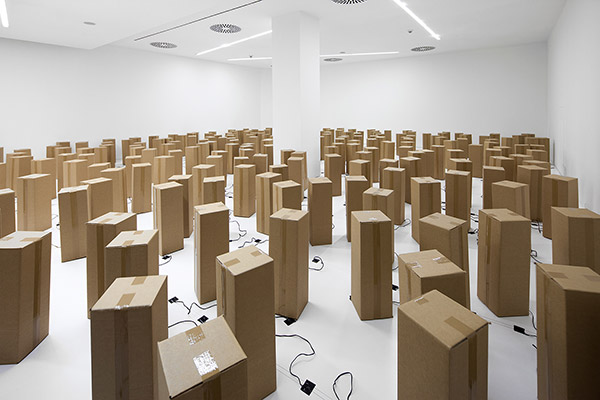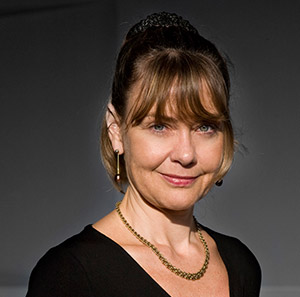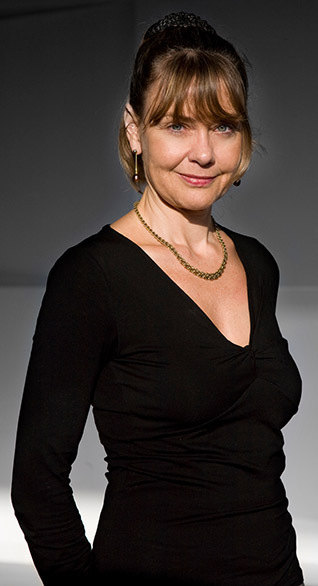By Sherry Dobbin
Biography:
Christiane Paul is Associate Prof. and Associate Dean at the School of Media Studies, The New School, and Adjunct Curator of New Media Arts at the Whitney Museum of American Art. Her recent books are A Companion to Digital Art (Blackwell-Wiley, May2016); Digital Art (Thames and Hudson, 3rd revised edition, 2015) Context Providers – Conditions of Meaning in Media Arts (Intellect, 2011; Chinese edition, 2012), co-edited with Margot Lovejoy and Victoria Vesna; and New Media in the White Cube and Beyond (UC Press, 2008). At the Whitney Museum she curated exhibitions including Cory Arcangel: Pro Tools (2011) and Profiling (2007), and is responsible for artport, the museum’s portal to Internet art. Other curatorial work includes Little Sister (is watching you, too) (Pratt Manhattan Gallery, NYC, 2015); What Lies Beneath (Borusan Contemporary, Istanbul, 2015); The Public Private (Kellen Gallery, The New School, NYC, 2013); Biennale Quadrilaterale 3 (Rijeka, Croatia, 2009-10); and Feedforward – The Angel of History (co-curated with Steve Dietz; LABoral, Gijon, Spain, 2009).
Sherry Dobbin: Christiane, I find it fascinating to speak with you as I began programming for the Midnight Moment as an active immersive experience and calling more upon my experience with performance than an academic knowledge of the full history of the moving image. Selfishly, I want to focus a bit on your expertise with the dialogue between art and technology in this conversation. First, can you give a brief context for how ‘new’ is this dialogue between technological labs and artists?
Christiane Paul: “Artists in Labs” have a long history. One of the more notable examples would be the collaboration between artists and technologists at Bell Labs in the 1960s and 1970s, which brought together people such as Ken Knowlton, Leon Harmon, Stan Vanderbeek, Lillian Schwartz, Laurie Spiegel, and Emmanuel Ghent. A lot of the experimentation at Bell Labs focused on software-based image manipulation, and the collaborations resulted in the development of several programming languages. Another example would be Xerox’s interdisciplinary Palo Alto Research Center (PARC) and its Artist-in-Residence Program (PAIR), which paired new media artists with researchers who used the same media in different contexts. And Experiments in Art and Technology (E.A.T.) is most important as an organization explicitly devoted to creating collaborations between artists and engineers.
SD: It is very important to note that often an interest in the same subject may not necessarily lead to partnership. In other words, even a great dialogue may not mean that a collaboration will form naturally. Have you experienced this when strategic partnerships are suggested across arts-technology or arts-science initiatives? And when it does work, what is that makes a collaboration form and be mutually beneficial?
CP: These are great questions and quite a few initiatives have been trying to answer them. It’s important to keep in mind that dialogue does not necessarily mean collaboration. The digital age has the potential to bridge various gaps between art, technology, and science, and art-sci-tech collaborations can lead to hybrid practices and new forms of knowledge production. Artists, scientists and technologists typically have different goals and agendas — technologists and scientists are not necessarily invested into the aesthetics of visual or abstract concepts (although they can be) — which can lead to very interesting experimentation. A certain amount of tension in the dialogue always is a given. Ken Knowlton describes his experiences in the essay “On the Frustrations of Collaborating with Artists.” Making a collaboration mutually beneficial requires finding a common language and vocabulary in interdisciplinary exchanges and carefully defining ones roles. And then there simply needs to be a common interest and human connection.
SD: If it is the case that artists have been exploring the development of technology along with the commercial sector for so long, can we determine a particular cycle of behavior?
CP: I think it would be difficult to create an overarching narrative of patterns and cycles of behavior for either the exchanges between artists and the commercial sector or the evolution of technologies themselves. There definitely is a pattern of early experimentation with ideas and concepts that can’t yet be implemented because the technology lags behind, are consequently abandoned and then resurrected after a while. Virtual reality and the head-mounted display would be one example.
SD: How are we dissecting ways of experience with technology?
CP: Our ways of experiencing technology are extremely complex and difficult to delineate but there certainly is a matrix for these experiences. One of the crucial elements in this matrix is the relationship between the virtual and the physical and how our senses perceive the intersection between them. There are huge differences between the ways in which our senses engage with browsing the ‘virtual space’ of the Internet through a computer as opposed to being immersed in a virtual reality world, or having virtual elements overlaid onto the physical world, or engaging with the virtual through phones, tablets and networked devices (from watches to bracelets). Both degrees of immersion and the respective interfaces of the technological devices are perceived differently by our senses and have distinct visual, aural, and haptic haptic effects. Levels of interaction and agency are yet another important aspect in the experience of technology.

SD: Yes, it is key to consider the body in varying relationships to the technology and not to assume that this interaction is passive. The devices make us the giants of our own narratives, we also seek experiences such as Midnight Moment or IMAX or Ryoji Ikeda’s The Transfinite to move our bodies within the technology, and virtual reality allows the body a movement it may never be able to achieve. Are we pioneers today or has this always been integral to man’s relationship with exploring the ability to visualize our bodies through technological intervention?
CP: We have used technologies to extend and visualize our bodies for centuries, from microscopes and telescopes to technologies of representation such as photography and film. The body’s relationship to technologies always is a very active one and there are two main aspects to it: the ‘enacted’ body as our embodied experience of the world, the way we position ourselves and our mobility within a given environment; and then the represented body, the images we create of our bodies. Both are affected by technological evolution. Immersive technologies — from the early three-screen Polyvision format used by Abel Gance’s in his 1927 film Napoleon to the Oculus Rift — change our embodied experience, and imaging technologies influence the way we represent ourselves.
SD: How does the technological representation of our bodies relate to the ways in which we are exploring connectivity through technology?
CP: Connectivity is yet another important element of that matrix of technological experiences. The networked aspects of technologies, from the early days of the Web to today’s social media platforms and messaging applications, have changed the way we communicate and connect. Connection is yet another complex construct, ranging from the capacity to instantly reach a large amount of people to a deep emotional relationship with other people or embeddedness in a physical community. I wouldn’t say that we are more connected than we used to be without digital technologies, but the nature of connectivity has profoundly changed. In Alone Together Sherry Turkle has outlined how relentless connection can also lead to a new solitude.
SD: Do you think this is all a linear progression that the technological visionaries could have predicted? Or are there surprises that challenge the linear progressive theory of development?
CP: There certainly have been many technological visionaries who developed and predicted our networked technological world — from Hedy Lamarr, Ted Nelson and Douglas Engelbart to Buckminster Fuller and sci-fi writers such as Philip K. Dick. At the same time I don’t think that technological evolution is ever linear. Media archeology as a discipline has unearthed many interesting instances of technologies that were abandoned and resurrected in different forms. You could draw a direct connection between pre-film animation devices such as the zoetrope and the digital loop and animated gif, but there hardly was a linear progression from one to the other. The history of technology is full of surprises.
SD: How is technological ‘advancement’ affecting the way in which we see? In a time of the constant tracking of human movement — whether from surveillance footage or cameras that count pedestrian heads in Times Square or the trail of data left by our likes and postings — do we tell a more thorough story of ourselves?
CP: I’m not sure if it is a more thorough story but certainly a more data-driven and quantifiable one. Corporations and government agencies are tracking our movements in virtual and physical space, and we are willingly creating our data portraits online or as part of the quantified self movement, the logging of our lives through fitness bracelets and other devices. Yet the ways in which that data is gathered and processed is always biased — certain aspects are omitted, others overemphasized or not correlated the way they should be — so the depth of the story becomes questionable. It is particularly interesting to me how the way in which we see the world has changed. We are “Waving at the Machines,” as James Bridle would put it, increasingly adjusting our ways of seeing the world in terms of how technology sees and reads us. I am particularly interested in today’s computer vision and image recognition technologies, such as Google’s Deep Dream or Carnegie Mellon’s LiveLight, which relies on an automated method of “curating” and editing short video clips. How will the way in which machines see in turn influence the way humans evaluate images?
SD: What questions are artists exploring in this time of ever more software affecting our lives? What is the most crucial role you see artists providing?
CP: Art has always been a great arena for asking the harder questions, the questions you didn’t even know to ask. Artists can crack open technologies and explode them to ensure that narratives of techno-utopia and technological efficiency do not overshadow a critical perspective on the social and cultural implications of technology. I do not mean to suggest that art has to function as a ‘corrective’ to corporate interests — asking questions and opening up new perspectives on any given technology is more than enough. Some of the artists working with digital technologies today are exploring issues ranging from image recognition and surveillance to the role of AI and intersections between virtuality and physicality.
Interviewer
Sherry Dobbin is the Creative Director & Director of Times Square Arts at the Times Square Alliance. Since February 2012, she has developed programs for Times Square’s electronic billboards, public plazas, vacant areas, popular venues, and online platforms. Ms. Dobbin brings over 20 years international experience across performance and visual arts, and art in the public realm, where she has worked as producer, administrator, consultant and curator. Prior to Times Square, she was the Director of Robert Wilson’s The Watermill Center and a Project Director of arts-led regeneration throughout London and Eastern UK. Ms. Dobbin sits on advisory and review panels for cross-disciplinary arts organizations, including PULSE Advisory Committee, The Laundromat Project, Eyebeam and Open House New York, and co-teaches “The Arts & Artist in Urban Revitalization” at the NYU Robert F Wagner Graduate School of Public Service.



One thought on “Art Science Tech – Sherry Dobbin in conversation with Christiane Paul”